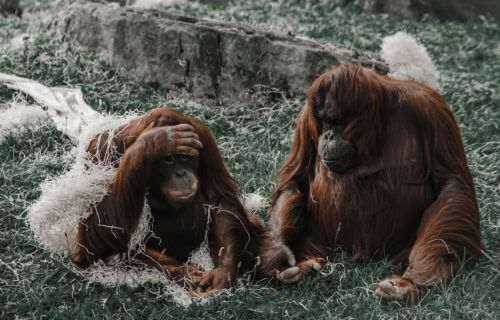COVENTRY, United Kingdom — Orangutans really can “talk” — maybe not exactly like King Louie in “The Jungle Book,” but close enough — according to new research.
Walt Disney’s rowdy character, who was crowned “King of the Apes,” might just hold the key to discovering the origins of human speech. The ability to communicate using consonants as well as vowels dates back to early tree-swinging ancestors, scientists say.
Orangutans, the most arboreal of the Great Apes, communicate using a complex repertoire of sophisticated calls. The sounds are of greater variety than those of gorillas, bonobos, and chimpanzees — their African ground-dwelling cousins.
Emergence of Homo sapiens’ talking skills have baffled evolutionary experts for decades. Clues have now been identified in the lifestyle of the critically endangered orangutan, one of our closest evolutionary relatives.
“All apes are accomplished extractive foragers,” says lead author Professor Adriano Lameira from the University of Warwick in a media release.
“They have developed complex mechanisms to access protected or hidden foods like nuts or plant piths, which often requires either meticulous use of hands or tools. Apes such as gorillas and chimpanzees need the stability of the ground in order to successfully handle these foods and use tools, however orangutans are largely tree-dwelling, and access their food up in the canopy, where at least one of their limbs is constantly used to provide stability among the trees.”
“It is because of this limitation, that orangutans have developed greater control over their lips, tongue and jaw and can use their mouths as a fifth hand to hold food and maneuver tools,” Dr. Lameira continues.
“Orangutans are known for peeling an orange with just their lips so their fine oral neuro-motoric control is far superior to that of African apes, and it has evolved to be an integral part of their biology.”
How did modern speech evolve?
The study suggests that living in trees was a preadaptation for the emergence of consonants and the evolution of speech. It would also show our own evolutionary ancestors lived a more tree-dwelling lifestyle than previously thought.
Spoken language is composed of vowels and consonants that take the form of voiced and voiceless sounds, respectively. The latter relies on the tongue, teeth, and lips. Calls of non-human primates are composed primarily or exclusively of vowel-like sounds.
“This raises questions about where all the consonants, that compose all the world’s languages, originally come from,” Dr. Lameira says.
“Existing theories of speech evolution have thus far, focused exclusively on the connection between primate laryngeal anatomy and human use of vowels. This doesn’t explain though, how voice-less, consonant-like sounds became a fundamental component of every language spoken around the globe.”
How do orangutans differ from other primates?
Researchers compared patterns of consonant-like vocal production in the vocal repertoire of lineages that survive from a once-diverse family — including orangutans, gorillas, bonobos, and chimpanzees.
“Wild gorillas, chimpanzees and bonobos don’t use a huge variety of consonant-like calls,” the researcher explains.
“Gorillas for example, have been found to use a particular consonant-like call, but this is only prevalent in some gorilla populations and not others. Some chimpanzee populations produce one or two consonant-like calls associated with a single behavior, for example while they are grooming, but these same grooming calls are uncommon in other chimpanzee populations.”
“Wild orangutans, however, use consonant-like calls universally and consistently across different populations and for multiple behaviors, much like humans do with speech. Their vocal repertoire is a rich display of smacking, clicks, kiss-sounds, splutters and raspberries,” Lameira concludes.
Orangutans are threatened with extinction because of the destruction and degradation of lowland forests in Borneo and Sumatra. Prof. Lameira has observed them in their natural habitat throughout the last 18 years.
The study is published in the journal Trends in Cognitive Sciences.
South West News Service writer Mark Waghorn contributed to this report.

